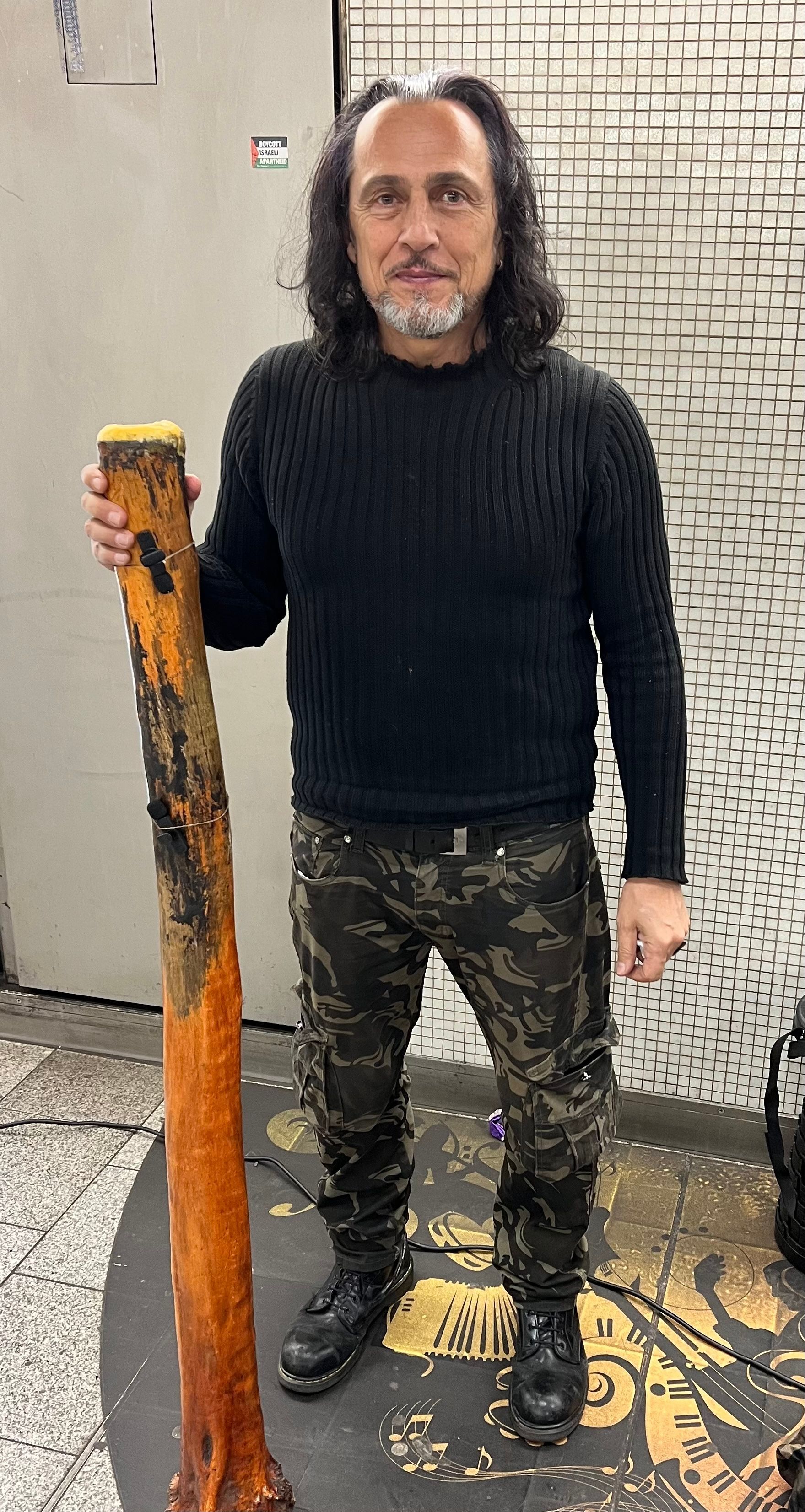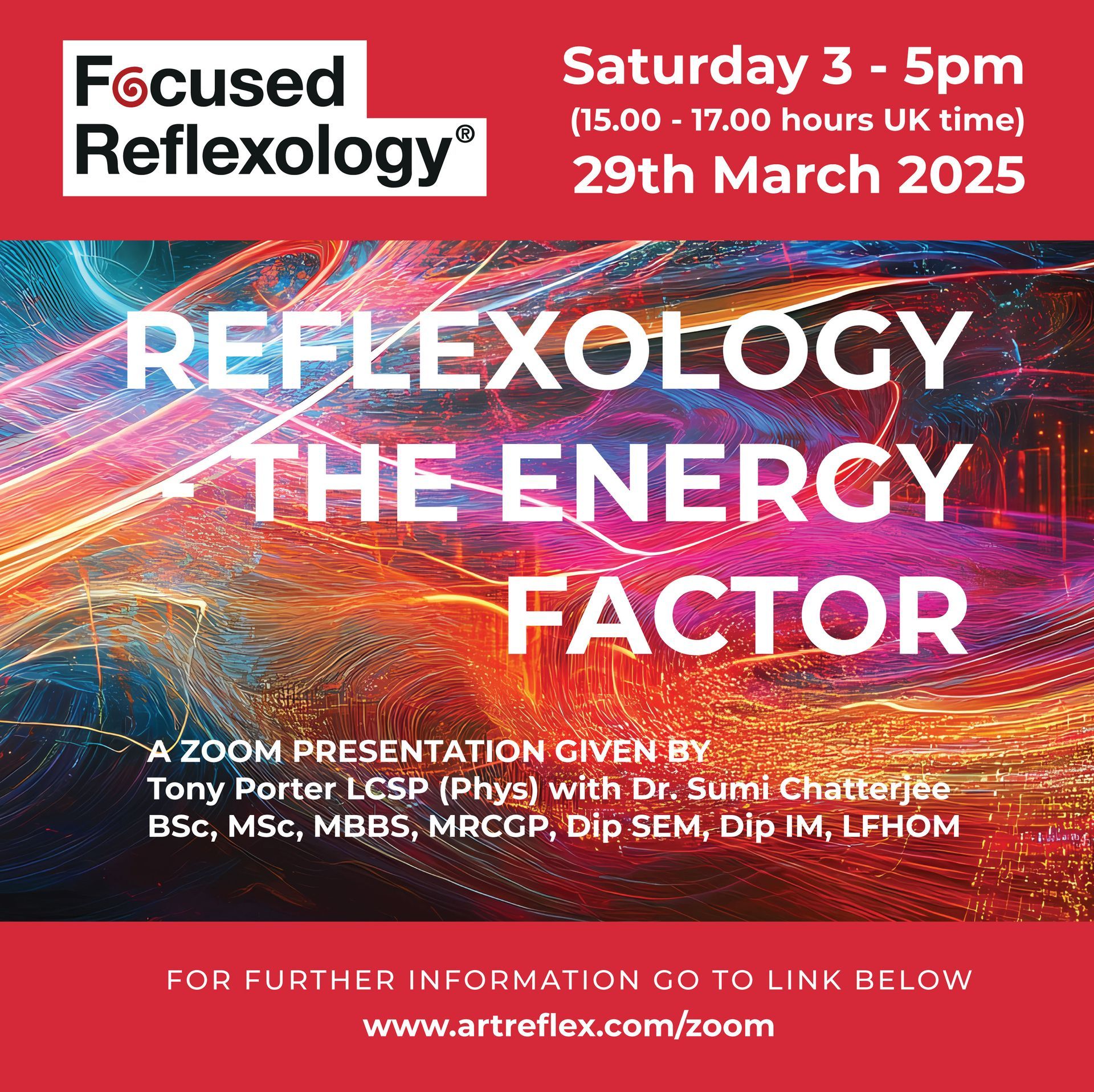
Reflexology decoded - an online presentation by Tony Porter Saturday November 9th Start time 3.00 pm (15.00 hours UK time) Duration: approximately two hours Cost £40.00 Reflexology is a multifaceted therapy akin to an elusive butterfly that never stays in one place for long; its movements are impossible to predict. I've spent nearly six decades as a reflexologist trying to understand this elusiveness. While I can't claim to have fully grasped it, I have become aware of the reasons behind it. This has given me a deeper understanding of reflexology and transformed the effectiveness of my treatments. My intention for this presentation is to help fellow reflexologists gain a better and clearer understanding of the therapy. This includes becoming aware of how the client’s (and, equally importantly) the practitioner's levels of Qi or electricity affect treatment outcomes. Strategies for quickly increasing these will be discussed and demonstrated. Reflexology offers a life-changing opportunity for practitioners willing to challenge conventional norms. This enables a more therapeutically valuable service to clients, which, after all, is the purpose of our work. Overview of subjects Classical reflexology defined. The reflexes can tell interesting stories if we know how to interpret them. Understanding the "law" of the "disturbed" reflex. Is it necessary to work all the reflex areas of the feet? Treating what you find and not what you are looking for. The advantages of splitting a treatment into two phases. Utilising the appropriate types of techniques to match each client's unique reflex status. The Slippery Slope: Working with an Emollient - Good or Bad? Electricity (life force, Chi, Qi, etc.) levels in the client and practitioner are a significant factor in treatment response. The piezoelectric action of reflexology. I look forward to meeting you at the presentation (early booking is advised). My Best wishes Copyright 2024 Tony Porter Founder Focused Reflexology/ A.R.T.®

THE ENERGY FACTOR Part 2 Reflexology, with its captivating elusiveness, stands out among other manual therapies. Its actions are multifaceted, akin to an elusive butterfly that never settles in one place for long. To truly grasp its elusiveness, we must cast our nets wide and develop the ability to discern the subtle changes in the tissues of the reflexes — what I identify as a disturbed reflex. It's important to note that many reflexologists may not work in a way that allows them to become aware of these changes. However, this presents an exciting opportunity for future exploration, which we will explore in a future article. A disturbed reflex displays a texture or ‘feel’ that differs from its surrounding tissue. There are various types of textures, from the crystals described by Eunice Ingham to those with a more subtle identity. Once this ability has been developed, the practitioner will become in tune with the energy that gives animation to all life forms. That energy is —electricity. The feet are receptors of the electromagnetic energies from the earth. They serve as a two-way communicator between the earth and the brain, not forgetting to and from the therapist. The feet serve as electromagnetic communication centres. The quote below explains this very well: ‘Each cell in the body is a tiny, complex electrical system which picks up magnetic impulses not only from the atmosphere but especially from the ground. Hence the tactile hypersensitivity of the toe tips and sole of the foot is no coincidence, but part of our natural equipment to ‘pick up’ these electro magnetic forces and convey them through the body’. - James Beal NASA’s Space Centre: As reflexology practitioners, we need to be aware of the electrical circulation of the body, as well as that of the blood, lymph, and, of course, oxygen. In ancient cultures, electricity was described as Qi, life force, chi, vitality, ka, etc., vital force. In acupuncture, electricity or Qi is said to flow in channels (or vessels) known as meridians. In Ayurvedic medicine, it is called prana and is said to flow through a complicated network of vessels or channels called Nadis, of which there are said to be 72,000. ‘Circulation is life; stagnation is death’, a wise maxim that applies not only to blood circulation but also to electricity. It is a resistance to this energy that creates a disturbed reflex. My life in reflexology has taught me much about reflexology. One of the most valuable factors is the variation of each client's reflex sensitivity status. This showed that those with a generally dull reflex status were slow responders to treatment, while those with lively and easily detected reflexes would have a strong response. This led me to discover that a painful reflex does not necessarily indicate a problem in its referred pathway. On the contrary, in health, feet should display robust and sensitive reflexes, a sign of high levels of Qi or vitality throughout the body. This explains why the reflex status of people with serious or terminal diseases will become less evident as the disease progresses due to the decreasing levels of Qi. This is evident in those not receiving analgesic medication. In addition to the client's energy status, I became aware of my own energy status and how its fluctuations affected my treatments. I would begin most days with an early morning run, but sometimes I extended my running time, and even though I felt good afterwards, something seemed missing from my treatments on those days. Clients remarked that my touch felt empty and my treatment lacked its usual effectiveness. This made me question how the practitioner's Qi levels affected treatment outcomes. My investigation led me to discover that ancient schools of therapeutic knowledge emphasised the practitioner's health as much as the patient’s. A few years later, during a visit to China, I met a famous acupuncturist who explained the same energy factor. As a point of interest, she told me that working on the feet was deemed bad for the practitioner; for this reason, reflexology was not practised except in public bathhouses for insomnia. (this is for another article). She explained that to build or restore Qi; we need to stand barefoot on grass or the earth and breathe the energy up through the feet (from the kidney 1 acupuncture point — an example of the benefits of grounding). Since then, I have discovered much about restoring and increasing the body's Qi, which, in my case, always leads to more effective treatments. I found that jogging for a too long duration, particularly on my treatment days, had a negative impact on the therapeutic effectiveness of treatments. Interestingly, a gym workout with weights did not have the same detrimental effect. It seems that anaerobic resistance exercise can stimulate Qi. Strategies to increase Qi Since then, the most effective way for me to increase and restore my Qi has been the practice of pranayama (the science of breath). (I began this practice many years ago after being diagnosed with having an inherited cardiological issue.) Those who regularly practice breath work will experience the circulation of Qi through the body, particularly in the fingertips and toes. In my experience, this energy is shared with the client, giving treatments a touch of magic. Ancient schools of health taught practitioners how to build and maintain good health and vitality for its value in treatments. Some activities which reduce Qi Too long duration of aerobic exercise (on treatment days) Lack of sleep Excessive alcohol Poor breathing Dehydration Some activities to increase Qi Breathwork, particularly each morning. (Including abdominal breathing, which can be performed in unison with humming — both are great vagus stimulants.) Abdominal massage Splashing the face with cold water is another vagal stimulant. Pilates Meditation Reiki I have touched a single thread of a vast tapestry of lost knowledge. I know many practitioners practice my suggestions regularly, some of whom are leaders in this field. I will expand on this subject later in one way or another. I conclude with this thought: ‘The body distils its own miraculous medicines’ — if given a chance. My Best wishes Tony Porter

During my physical therapy training, students were told that for every case of back pain successfully treated, at least two new clients would be brought to the practice. I can vouch for this. As Low Back Pain (LBP) is the most common pain practitioners encounter, let us explore how it applies to reflexology. My experience has shown that reflexology can be highly efficient in easing or eliminating the distress caused by this condition and can provide a positive boost to satisfied clients. The treatment of LBP is a convenient subject to explain the gist of this article. Reflexology is more than following a chart and applying contact to a reflex, which the practitioner assumes needs to be worked on instead of letting the feet tell stories through their reflex status. Eunice Ingham, The Mother of Reflexology, gives clues to this through her books, ‘Stories The Feet Can Tell’ and ‘Stories The Feet Have Told.’ Yet, how many reflexology practitioners work this way by letting the reflex status of the feet tell the stories? The subject of LBP is convenient for explaining the concepts that I devised through A.R.T./Focused Reflexology, where the principle focus is on the practitioner becoming aware of the reflex disturbances on the feet and applying the appropriate types of contacts rather than the practitioner applying contacts to the reflexes that they believe need to be treated. In a previous blog, I mentioned the importance of examining the hip reflexes, as it is an imbalance here that can be the primary cause of LBP. In addition, the feet need to be thoroughly mobilised using various techniques, including thumb walking counter-flexion of the plantar cuneiform and metatarsal joints. This has to be a focused and deep movement that can only be performed without lubrication! Most reflexologists are unaware of and unable to perform this technique. A weak ‘tweak’ of feet dripping in oil will not achieve what I explain here. Lubrication can be used when necessary and with the appropriate techniques. However, it cannot be used in conjunction with the classical ‘walking’ techniques. In this case, it is not reflexology but a dilution denigrating the therapy being used. Also, when the feet are treated with positive and focused techniques without lubrication, the accompanying stretching and stressing of the skin and underlying structures of the feet (including the fascia) produces a beneficial electrical potential which would not occur if a lubricant is used, as the fingers and thumbs would just slide over the skin. The ankles must be rotated in all directions, including plantar and dorsiflexion. This serves two purposes: one is to find if there is a restriction to one ankle more than the other, which is an indication of lumbar/pelvic tightness on the same side as the restriction (ruling out if there has been an injury to the ankle) The other purpose is to help loosen the pelvic region, which takes place through the rotation of the ankles. Before my reflexology life, I had built a busy and successful remedial and physical therapy practice in North London. People came to me for their painful ailments, and LBP was the most common. Some were in so much pain that massage on the body was out of the question. I found that a deep and exclusive massage and mobilisation of the feet would at least reduce the pain and increase mobility (which is a precursor to accelerating the healing process), or the pain they presented was reduced to a minimum after the first treatment. Although reflexology is not massage in the strictest sense, it demonstrates that LBP needs to involve examining and working all the reflex areas of the feet, not just the symptomatic. Through this, I built a very successful practice with a three-week waiting list. The advantage of treating LBP through the feet is that, apart from promoting general physical relaxation, it gives clients a boost to their mood, which is often affected by pain, and without manipulation. The Fascia, It is the ubiquitous corset and support of the body and acts as a communication network and matrix of the body. Therefore, it is of significant consideration in LBP and many other conditions. While on the subject, the fascia is responsible for most of the reflex communication of the body. With the appropriate types of techniques, the feet provide an excellent way to influence the fascia. Nothing in the body takes place in isolation — everything is connected, and LBP is no exception. This is why all areas which show unusual tension and textures need to be part of the treatment for LBP. I mentioned in my previous Blog about relying on foot charts. These charts are helpful, particularly to reflexology novices. However, continually relying on them severely limits reflexology's potential. I cannot emphasise enough how reflexology is about cultivating the ability to sense what is going on under our fingertips and then applying the appropriate range of techniques. For example, when treating a client with LBP, work over the feet with the fingers and thumbs and then include the mentioned mobilisation techniques. Rotate the ankles, palpate, loosen, knead and rotate the metatarsals. Twist the medial areas of the feet. Apply positive and focused pressure with the thumbs and include the counter-flexion movement. Work the plantar and dorsal areas of the toes with thumbs and index fingers. These movements are performed with authority and not brutality. Even after all these years, I still get great professional satisfaction when I feel the feet under my hands becoming softer and more flexible. When this happens, areas of tension are revealed; for example, perhaps the lateral metatarsal joints are tighter on one foot than the other, and the areas of the cuneiforms can show tighter on one foot than the other, or a shoulder reflex shows as disturbed. These are vital indications of imbalance, and they must be considered involved in LBP. Therefore, they need to be worked on until they become more normalised. There is a meaning behind reflexology—a golden thread uniting all parts of the body (and mind). Working in this way is what it means to become in tune with reflexology's deeper potential. Remember to ‘Treat what you find and not what you are looking for’! I will arrange online presentations on this subject and the techniques as soon as possible, which will be announced through these channels. My Best Wishes Tony Porter ©️

I had the immense privilege of knowing and working alongside the late Dr. Barry Peatfield for over thirty years. Dr. Peatfield was a remarkable individual who dedicated his life to the study and treatment of metabolic disorders, particularly Hypothyroidism. His unconventional approach, especially towards this condition, although successful garnered both admiration and criticism from the medical establishment of his time. In fact, it was this very opposition that eventually led him to voluntarily remove himself from the medical register. One of my fondest memories of Dr. Peatfield was during a leisurely lunch at his favourite country pub a year or so before his passing. Our conversation naturally gravitated towards all things thyroid, which continued long after we returned to his home. Over the years, Dr. Peatfield graciously shared his wisdom with my A.R.T. students through engaging lectures, and he was an unwavering supporter of reflexology.







